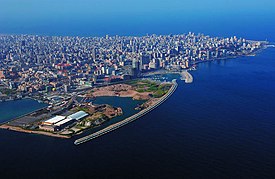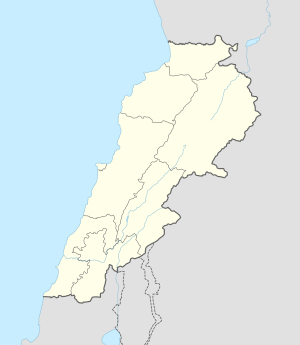Beirut
Beirut بيروت Bayrūt Beyrouth (French) | |
|---|---|
Ceety | |
 | |
| Coordinates: 33°53′13″N 35°30′47″E / 33.88694°N 35.51306°E | |
| Kintra | Lebanon |
| Govrenorate | Beirut, Caipital Ceety |
| Govrenment | |
| • Mayor | Bilal Hamad |
| Area | |
| • Ceety | 20 km2 (8 sq mi) |
| • Urban | 100 km2 (40 sq mi) |
| • Metro | 200 km2 (80 sq mi) |
| Population | |
| • Ceety | 750,000 |
| • Urban | 1,900,000 |
| • Metro | 2,250,000 ~ 3,000,000 |
| Time zone | +2 |
| • Summer (DST) | +3 |
| Website | Ceety o Beirut |
Beirut (Arabic: بيروت, Bayrūt) is the caipital an lairgest ceety o Lebanon wi a population rangin frae some 1 million tae ower 2 million as o 2007. Locatit on a peninsulae at the midpoint o Lebanon's coastline wi the Mediterranean sea, it serves as the kintra's lairgest an main seaport, an an' a' forms the Beirut Metropolitan Aurie, which consists o the ceety an its suburbs. The first mention o this metropolis is foond in the ancient Egyptian Tell el Amarna letters, datin tae the 15t century BC, an the ceety haes been continuously inhabitit syne.
Beirut haulds Lebanon's seat o govrenment, an plays a central role in the Lebanese economy wi its ceety centre, Hamra, Verdun, an Ashrafieh-based corporate firms an banks. The ceety is the focal point o the kintra's cultural life, renouned for its press, theatres, cultural activities, an nichtlife. Efter the destructive Lebanese ceevil war, Beirut unnerwent major reconstruction,[1][2][3] an the redesigned historic ceety centre, marina, pubs an nichtlife destricts hae ance again rendered it a tourist attraction. Beirut wis named the top place tae visit in 2009 bi The New York Times.[4] It wis an aa leetit as ane o the ten liveliest ceeties in the warld bi Lonely Planet in 2009.[5]
Internaitional relations
[eedit | eedit soorce]Twin touns – Sister ceeties
[eedit | eedit soorce]Beirut is twinned wi:
References
[eedit | eedit soorce]- ↑ Reconstruction of Beirut Archived 2009-01-16 at the Wayback Machine, Macalester College
- ↑ Lebanon's Reconstruction: A Work in Progress, VOA News
- ↑ Beirut: Between Memory and Desire, Worldview
- ↑ Wise, Zach; Meek/, Miki (11 Januar 2009). "The 44 Places to Go in 2009 - Interactive Graphic". Beirut (Lebanon);Washington (DC);Galapagos Islands;Berlin (Germany);Las Vegas (Nev);Hawaii;Vienna (Austria);Doha (Qatar);Dakar (Senegal);Phuket (Thailand);Chicago (Ill);Dallas (Tex);Bhutan;Florida Keys;Rome (Italy);Cuba;Penang (Malaysia);Seychelles Islands;Florianopolis (Brazil);Copenhagen (Denmark);Monument Valley;Great Britain;Cologne (Germany);Reykjavik (Iceland);Red Sea;Egypt;Deauville (France);South Africa;India;Kazakhstan;Buffalo (NY);Madagascar;Tasmania (Australia);Stockholm (Sweden);Alaska;Pennsylvania;Zambia: NYTimes.com. Retrieved 5 Mey 2009.
- ↑ "Beirut Travel Information and Travel Guide — Lebanon". Lonely Planet. 24 Mairch 2009. Retrieved 5 Mey 2009.
- ↑ a b c d e f g h i j k l "Twinning the Cities". City of Beirut. Archived frae the original on 21 Februar 2008. Retrieved 13 Januar 2008.
- ↑ "Isfahan, Beirut named sister cities". MNA. Archived frae the original on 12 October 2007. Retrieved 2 Mey 2007. Cite has empty unkent parameters:
|month=and|coauthors=(help) - ↑ "Sister Cities of Istanbul". Archived frae the original on 17 Januar 2010. Retrieved 8 September 2007.
- ↑ "Beirut, Lebanon". Lacity.org. Archived frae the original on 2 Mey 2009. Retrieved 5 Mey 2009.
- ↑ "Yerevan Municipality – Sister Cities". © 2005–2009 www.yerevan.am. Archived frae the original on 2 October 2011. Retrieved 22 Juin 2009. freemit airtin in
|publisher=(help)
| Wikimedia Commons haes media relatit tae Beirut. |
- CS1 errors: empty unkent parameters
- Beirut
- Amarna letters locations
- Auncient ceeties
- Auncient Greek steids in Lebanon
- Auncient mints
- Airchaeological steids in Lebanon
- Caipitals in Asie
- Populatit places in the Beirut Govrenorate
- Populatit coastal places in Lebanon
- Crusades
- Hellenistic colonies
- Mediterranean
- Mediterranean port ceeties an touns in Lebanon
- Phoenicie ceeties
- Phoenicie steids in Lebanon
- Roman colonies
- Roman steids in Lebanon
- Populatit places established in the 3rd millennium BC



